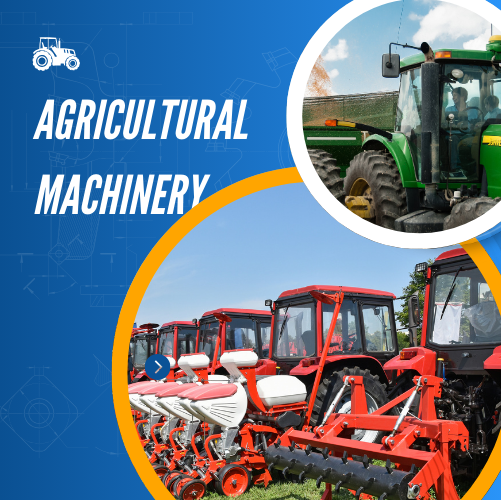Classic Rubber V-Belts: A Complete Guide for Power Transmission
Classic rubber V-belts are widely recognized for their durability, efficiency, and cost-effectiveness in transmitting mechanical power. Whether it’s in agriculture, automotive, or industrial machinery, classic V-belts are vital for smooth operations. At GPRindustrial.com, we supply a wide range of high-quality V-belts designed to meet your operational needs. In this guide, we’ll cover everything from types, applications, materials, maintenance, and how to choose the right belt for your machine.
Table of Contents
- What are Classic Rubber V-Belts?
- Types of Classic V-Belts
- Key Features of Classic Rubber V-Belts
- Common Applications
- How to Choose the Right V-Belt
- Maintenance Tips for V-Belts
- Why Choose GPRindustrial.com for V-Belts?
- FAQs
1. What are Classic Rubber V-Belts?
Classic V-belts, also known as standard V-belts, are a type of power transmission belt that features a trapezoidal cross-section. These belts are made of rubber compounds reinforced with cords, which provide strength and flexibility. The unique shape of the belt allows it to fit snugly into pulley grooves, ensuring efficient power transfer.
The main purpose of these belts is to transfer mechanical power between rotating shafts, typically from a motor to a drive. They are commonly found in machinery, automotive engines, agricultural equipment, and HVAC systems.

2. Types of Classic V-Belts
There are several types of V-belts, classified based on their size and shape. The most common types include:
- A Section V-Belt: Standard belt width, commonly used in light to medium-duty applications.
- B Section V-Belt: Wider than A-section, used in heavier-duty operations.
- C Section V-Belt: Larger belts designed for industrial machinery that requires high torque.
- D and E Section V-Belts: Heavy-duty belts used in demanding industrial applications.
At GPRindustrial.com, we offer V-belts in a variety of standard sections (A, B, C, D, and E) and metric sizes to fit different pulley configurations.
3. Key Features of Classic Rubber V-Belts
Classic rubber V-belts come with several key features that make them ideal for power transmission:
- High Durability: Made from high-quality rubber compounds that resist wear and tear.
- Efficiency: Designed for minimal slippage and efficient power transmission.
- Flexibility: Can handle misalignment between pulleys while maintaining tension.
- Heat and Oil Resistance: Many classic V-belts are treated to resist heat, oil, and other industrial contaminants.
- Quiet Operation: Reduced vibration and noise during operation, ideal for quiet environments.

4. Common Applications
Classic V-belts are versatile and used across multiple industries:
- Agricultural Machinery: For tractors, combine harvesters, and irrigation systems.

- Industrial Equipment: In conveyor belts, compressors, and pumps.
- Automotive: Common in older cars for driving alternators, water pumps, and air conditioning compressors.
- HVAC Systems: Used in fans, blowers, and other HVAC machinery.
- Home Appliances: Found in washing machines, dryers, and other motor-driven appliances

5. How to Choose the Right V-Belt
Choosing the right V-belt depends on several factors:
- Belt Size: Ensure the belt fits your machine’s pulleys. Refer to the manufacturer’s specifications for correct sizing.
- Load Requirements: Determine the torque and speed requirements of your application.
- Temperature and Environment: If the belt will be exposed to high temperatures or chemicals, choose a belt with the appropriate resistance.
- Type of Machinery: Some belts are designed specifically for high-torque machines, while others are optimized for light-duty applications.
At GPRindustrial.com, we offer custom belt consultations to help you find the exact belt you need.
6. Maintenance Tips for V-Belts
To extend the lifespan of your V-belts, proper maintenance is crucial. Here are some best practices:
- Regular Inspection: Check the belts for wear, cracks, or stretching. Replace them if any signs of damage are present.
- Proper Tensioning: Ensure that the belt is neither too tight nor too loose to prevent slippage and reduce wear.
- Alignment: Pulleys must be aligned correctly to avoid premature belt failure.
- Lubrication: Avoid lubricating V-belts, as oil can deteriorate the rubber material. Use special belt dressings instead.
- Cleanliness: Keep belts free of debris, dust, and oil to maximize their efficiency.
7. Why Choose GPRindustrial.com for V-Belts?
At GPRindustrial.com, we are committed to providing you with the best V-belt solutions. Here’s why you should choose us:
- Wide Selection: We offer a broad range of classic rubber V-belts from top manufacturers.
- High-Quality Products: All our belts are made from premium materials to ensure long-lasting performance.
- Expert Assistance: Our team of specialists can help you find the right belt for your specific needs.
- Fast Shipping: We provide quick and reliable shipping to get you back up and running in no time.
- Competitive Pricing: We offer competitive prices without compromising on quality.
8. FAQs
Q: How long do V-belts typically last?
A: The lifespan of a V-belt depends on the application and maintenance but typically lasts between 1,000 to 3,000 hours of operation.
Q: Can I use a V-belt in extreme temperatures?
A: Yes, but you must choose a belt that is rated for high or low temperature operations. Many belts offered at GPRindustrial.com have heat-resistant properties.
Q: How do I measure the size of a V-belt?
A: Use a V-belt measuring tool or check the manufacturer’s manual to find the correct size based on the belt’s width and length.
Conclusion
Classic rubber V-belts are essential for smooth and efficient power transmission in various industries. Whether you need a V-belt for agricultural, industrial, or automotive applications, GPRindustrial.com offers a wide selection of high-quality belts designed for durability and performance. With our expert assistance and fast shipping, you can trust us to deliver the best solutions for your needs.
For more information or to browse our complete selection of V-belts, visit GPRindustrial.com today.

